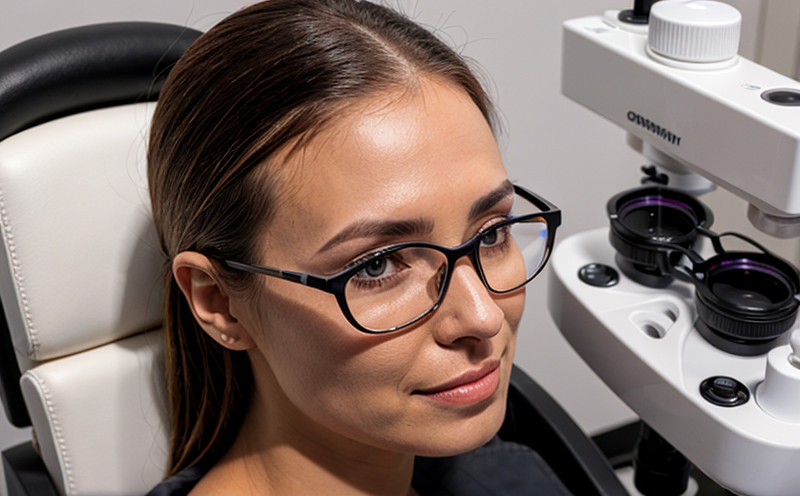ICH Q1E Evaluation of Stability Data Testing for Ophthalmics
The ICH (International Conference on Harmonisation) Q1E Guideline provides a framework to evaluate the stability data of ophthalmic products, ensuring their safety and efficacy over time. This service ensures that pharmaceuticals used in the eye meet stringent regulatory requirements set forth by global health authorities.
Stability testing is crucial for ensuring the quality, consistency, and shelf life of ophthalmic medications. The process involves exposing the product to various environmental conditions such as temperature, humidity, light, and time. The aim is to identify any changes that might affect the drug's potency or safety before it reaches the market.
The ICH Q1E guideline specifies stability testing protocols for ophthalmic products including solutions, suspensions, emulsions, and gels. It covers both single-dose containers (e.g., vials, ampules) and multi-dose containers (e.g., bottles). The testing must be conducted under conditions that simulate real-world storage and usage scenarios.
One of the key aspects of ICH Q1E compliance is the selection of appropriate stability-indicating methods. These methods should be able to detect changes in the product's chemical composition that could affect its efficacy or safety. The use of high-performance liquid chromatography (HPLC), UV-visible spectrophotometry, and other advanced analytical techniques ensures accurate measurement.
The testing protocol typically involves three stages:
- Initial stability testing
- Accelerated stability testing
- Long-term stability testing
In the initial stage, samples are exposed to conditions that accelerate degradation processes. This helps in identifying potential issues early on. The accelerated test results are then compared with those from long-term tests conducted under normal storage conditions.
The stability of ophthalmic products is evaluated based on several parameters including:
- Pharmacological activity
- Chemical and physical properties
- Bioavailability
- Safety profile
Accurate data collection and analysis are essential for determining the product’s stability over time. This involves regular sampling of the product during storage and assessing its quality using validated analytical methods.
The results from these tests are used to establish the shelf life of the ophthalmic product, ensuring it remains safe and effective until its expiration date. Compliance with ICH Q1E guidelines is critical for pharmaceutical companies aiming to meet regulatory requirements in multiple jurisdictions.
Our laboratory adheres strictly to these standards using state-of-the-art equipment and experienced personnel. We ensure that all tests are conducted under controlled conditions, replicating real-world storage scenarios as closely as possible.
Applied Standards
The ICH Q1E guideline provides the primary framework for evaluating stability data in ophthalmic products. It is supported by other relevant standards such as ISO 17025, which ensures that our laboratory meets international quality management system requirements.
We also comply with local regulations and guidelines specific to each region where our clients operate. This includes:
- US FDA (Food and Drug Administration)
- European Medicines Agency (EMA)
- PMDA (Pharmaceuticals and Medical Devices Agency, Japan)
The use of these standards guarantees that the data generated from our stability testing is accepted worldwide.
Our laboratory employs advanced analytical techniques to ensure precise measurement of various parameters. These include:
- HPLC (High-Performance Liquid Chromatography)
- UV-visible spectrophotometry
- Infrared spectroscopy
- Nuclear magnetic resonance (NMR) spectroscopy
These methods allow us to identify any changes in the product’s chemical composition that could affect its efficacy or safety.
We also follow Good Laboratory Practice (GLP) principles, which ensure the integrity and reliability of our data. This includes maintaining detailed records of all testing procedures and results, ensuring traceability throughout the entire process.
International Acceptance and Recognition
The ICH Q1E guideline is widely recognized by regulatory authorities around the world. Compliance with this standard ensures that pharmaceutical companies can market their products globally without additional testing or validation.
Our laboratory has received accreditation from leading accreditation bodies, including:
- American Association for Laboratory Accreditation (AALAC)
- CNAS (China National Accreditation Service)
- UKAS (United Kingdom Accreditation Service)
This recognition demonstrates our commitment to maintaining the highest standards of quality and reliability.
The ICH Q1E guideline is particularly relevant for pharmaceutical companies operating in multiple regions. By adhering to these standards, we ensure that all data generated from stability testing is accepted by regulatory authorities worldwide.
Our clients benefit from this international recognition as it facilitates easier compliance with local regulations and reduces the need for additional testing or validation when entering new markets.
Use Cases and Application Examples
The ICH Q1E guideline is applicable to all ophthalmic products, including but not limited to:
- Solutions
- Suspensions
- Emulsions
- Gels
Our laboratory has extensive experience in conducting stability testing for various types of ophthalmic products. Some notable examples include:
Eye Drops: We have successfully conducted stability tests on a wide range of eye drop formulations, ensuring their safety and efficacy over time.
Ointments: Our laboratory has evaluated the stability of various ointment formulations used in the treatment of ocular surface diseases.
Sterile Solutions: We have tested sterile solutions for use in intraocular surgery, ensuring they remain stable and free from contamination during storage.
Vaginal Preparations: Our laboratory has also conducted stability tests on vaginal preparations used to treat ocular infections. These tests ensure the products maintain their efficacy throughout their shelf life.
In all cases, our testing protocols are designed to replicate real-world storage and usage scenarios as closely as possible. This ensures that the data generated from these tests is highly relevant and reliable.
Our clients benefit from this comprehensive approach to stability testing, which helps them make informed decisions about their product development and regulatory compliance.





